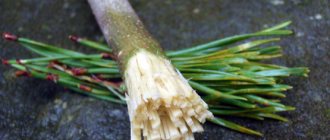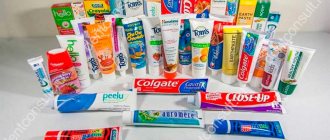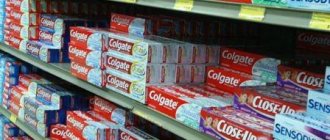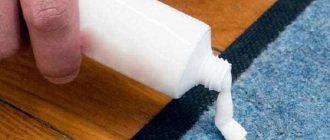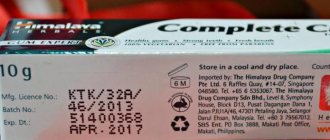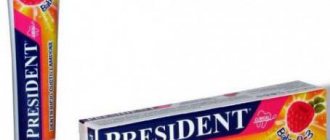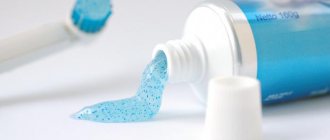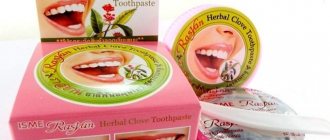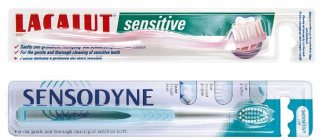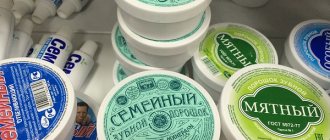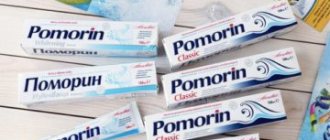In the beginning there was sand and chalk
Toothpaste and brush are everyday things with which our day begins and ends. However, they were once a real luxury. The ancient Egyptians were the first to think about oral hygiene and began to use sand, ash, ground stones and animal horns as a cleaning agent, and their own finger replaced the brush. In the 4th century BC. The great healer Hippocrates recommended using mixtures of pumice with the addition of wine vinegar, which are more gentle on tooth enamel, to prevent dental diseases. At the end of the 18th century, little had changed. For example, the British brushed their teeth with powders that included crushed brick, crushed bark and coal chips.
The prototype of modern toothpaste was invented by Americans in the 19th century. This time there were no stones or ash. Teeth cleaning products were a mixture of chalk powder, neutral soap and aromatic additives. It was only in 1873 that Colgate released the first toothpaste in glass jars, which replaced tubes two decades later. They were invented by dentist Washington Sheffield of New London. But Colgate beat the inventor by quickly registering a patent for itself. An interesting fact is that in Russia, most people at that time continued to brush their teeth with chalk-based powder, and only in the 50s it became possible to buy a familiar tube of toothpaste in stores.
Best toothpaste
Which toothpaste is better? Definitely one that meets a person’s needs and suits his indications. Until recently, the main task of toothpaste was to help the brush clean teeth from plaque. Today, modern manufacturers of hygiene products have expanded its functionality and began to offer special medicinal toothpastes, both complex and for targeted solutions to specific problems. Today you can find tubes not only for the prevention of caries, but also for bleeding gums, against the formation of tartar, paste for implants or smoker’s plaque, for fresh breath or restoring the pH balance of the oral cavity, as well as for much more. But, in fact, all pastes are divided into several varieties, which we will consider.
Application
- Hygienic. Remove dental plaque. Recommended for people with healthy teeth. Contains useful microelements and antiseptic additives.
- Fluorine-containing. Used to strengthen teeth. Fluoride-containing pastes should be used after consultation with a doctor: some filling materials are destroyed by fluoride.
- Medicinal. The composition contains antibacterial components, protects against caries, and helps prevent diseases of the teeth and gums. Natural extracts, oils, minerals, and biologically active components are used as additives.
- Whitening. Contain abrasive particles and additives to lighten tooth enamel. Recommended for occasional use. Does not eliminate the formation of tartar.
- Children's. They contain substances that have a positive effect on the health of baby teeth, strengthen gums, and disinfecting components.
- Anticarious. Active components penetrate into hard-to-reach places, strengthen enamel, and reduce tooth sensitivity. Ways to stop caries in the initial stages.
- Anti-inflammatory. For sensitive gums. Contains components with antibacterial, antimicrobial, hemostatic effects. Activate the processes of restoration of tissues and mucous membranes.
Pastes for the prevention of dental caries
Toothpastes for the prevention of caries are recommended for increased susceptibility to the formation of caries bacteria, as well as as restorative therapy after teeth whitening. They saturate dental tissues with useful minerals, prevent the growth of carious bacteria, and also fight the formation of plaque. To strengthen teeth, fluoride compounds are added to such pastes. It is contained in such pastes as “Day and Night” Swiss Smile, Enzycal 950 CURAPROX, Mirafluor C Miradent, “Power of a Smile” Jason and others. Fluorine is an important microelement, since it is the one that participates in the metabolism of calcium, and, therefore, ensures its presence in the enamel. But it is worth remembering that it is extremely toxic, so its amount entering the body should not exceed the established norm. People living in areas with fluoride-saturated water (more than 1.2 mg/l) are advised to use fluoride-free toothpaste. You can find out about the fluoride content in the water in your area by calling the nearest Sanitary and Epidemiological Station.
Toothpaste
Theodent Classic
Anti-caries pastes that restore enamel
Such products are designed to combat enamel demineralization and prevent the development of caries at the white spot stage. Pastes are based on calcium compounds or fluorides. You should not use products that contain both types of compounds. The fact is that fluorine and calcium react and form an insoluble residue, which means that during cleaning no active ions are released and no recovery occurs.
Calcium-containing pastes can be used every day. They are designed to correct mild thinning of the enamel.
Fluoride-containing pastes are designed to restore seriously damaged enamel. They can only be used with the permission of a doctor, as there is a risk of getting excess fluoride in the body. This can lead to brittle bones and teeth. Such products are used no more than twice a week. For greater effectiveness, they can be alternated with calcium-containing pastes.
Pastes against tooth sensitivity
There are special toothpastes for sensitive teeth. They contain potassium chloride, potassium citrate (Twin Lotus Recipe for Sensitive Teeth, Mirasensitive hap+) or strontium chloride. These substances “clog” the dentinal tubules and reduce hyperesthesia. They also saturate the tooth enamel with minerals, the deficiency of which is most often the cause of increased sensitivity of enamel and dentin. But the most progressive substance today is considered to be hydroxyapatite (Sensitivity Control Biorepair). Its crystals are similar in composition to tooth enamel, so they effectively combine with it, restoring the natural protection of teeth. Pastes for sensitive teeth should not contain a drop of chemical bleaches and, instead of coarse calcium carbonate, should contain gentle abrasive substances with a smaller particle diameter, for example, silicon oxide. Such pastes are recommended for hypersensitive teeth, as well as for use during and/or after teeth whitening procedures.
Sensitivity Control Biorepair toothpaste
Pastes for strengthening gums
Toothpastes aimed at preventing and reducing periodontal inflammatory processes reduce bleeding gums, help strengthen them, have an astringent effect, and also destroy harmful microbes. They most often contain antibacterial substances, for example with chlorhexidine, as in Curaprox ADS 712 paste, together with plant extracts that have an anti-inflammatory effect, such as edelweiss and echinacea in the SWISS SMILE vitamin herbal paste or witch hazel and calendula in the Plus Parodontgel BioRepair paste. Some of them also contain chlorophyll and vitamin E. All of these substances have a beneficial effect on gum tissue, accelerating the healing process and the formation of new cells. Such pastes are recommended for diseases of stomatitis, gingivitis and periodontitis.
Toothpaste Curasept ADS 712 CURAPROX
Sensodyne Comprehensive Protection
Brushing your teeth with this product means restoring enamel and healing your mouth.
- A good paste should contain, like this one, potassium nitrate, which significantly reduces the degree of vulnerability of crowns and inflammatory processes in the mucous layers of the gums.
- The absence of harmful sodium in it allows you to fight aggressive food components that destroy dentin.
- Fluoride perfectly restores damaged enamel and makes it smoother.
Users note that cleansing is gentle, there is no feeling of discomfort, or a feeling of excessive freshness.
Pastes against bad breath
The action of toothpastes that help fight halitosis is aimed at restoring the normal balance of oral microflora, the disruption of which is usually accompanied by excessive proliferation of anaerobes. These substances emit volatile sulfur-containing products that have a pungent odor. Anti-bad breath pastes contain components that suppress pathogenic microflora and act on viruses. In addition, such pastes eliminate dry mouth syndrome, which can also cause halitosis. Antihalitic hygiene products are recommended for bad breath caused by microflora disturbances and dry mouth.
Enzymatic toothpaste gel
Jason Enzyme Brightening
Toothpastes containing various dietary supplements
Toothpastes containing biologically active additives have anti-inflammatory and regenerative effects, which allows them to be used in the treatment of gingivitis, periodontitis and other diseases of the oral mucosa.
TOOTHPASTE “PRIMA”
Prima toothpaste contains vitamin B5 and has anti-inflammatory and regenerative effects.
TOOTHPASTE “BOROGLYCERINE”
Boroglycerin toothpaste contains 10% boroglycerin, which provides it with active antiseptic, bacteriostatic, bactericidal, fungistatic and fungicidal effects. The paste is advisable to use for acute and chronic candidiasis, stomatitis, glossitis and cheilitis, as well as for inflammatory periodontal diseases (gingivitis, periodontitis and idiopathic periodontal diseases).
TOOTHPASTE “BERRY”
“Yagodka” toothpaste contains 7% boroglycerin, which also provides an antiseptic effect against Staphylococcus aureus. It is recommended to use it 3-4 times a day in the treatment of candidiasis.
TOOTHPASTE “NEW PEARL EXTRA”
“New Pearl Extra” is the first toothpaste that contains kelp seaweed extract, which enhances the body’s immune response. In a study conducted under the guidance of Professor Yu.A. Fedorov, it was found that this paste significantly reduces the severity of periodontitis due to the natural extracts included in the formulation.
Composition of toothpaste - which is better?
A dental hygienist can help you figure out which toothpaste is best for specific oral problems. When purchasing a product yourself, you need to pay attention to whether it contains substances potentially harmful to teeth. For example, coarse abrasive substances that negatively affect tooth enamel. These may be chalk or calcium carbonate, as well as aluminum oxides, which are prohibited in some countries. Nowadays, silicon dioxide is considered the best abrasive; it gently removes all dental plaque without having a negative effect on the enamel and gums. You can also find other safe abrasive substances in paste compositions—dicalcium phosphate or sodium metaphosphate.
You should be careful with toothpastes that contain triclosan or chlorhexidine. Brushing with such pastes may be necessary to treat inflammation in the gums or to eliminate bad breath. However, long-term use (more than 3 weeks) of paste with antibacterial substances can lead to disruption of the beneficial microflora of the oral cavity. If sodium lauryl sulfate is in one of the first places in the description of the composition (that is, its percentage is large), then it is also better not to buy such a paste. The fact is that this surfactant is responsible for foaming, but does not in any way affect the quality of cleaning. In addition, it has long been proven that even in small doses, sodium lauryl sulfate can negatively affect the body. This component is contained in all pastes from Blend-a-med, Colgate, Oral-B, Aquafresh, Karimed, Forest Balsam, some pastes from Lacalut, SPLAT, PresiDENT, and New Pearl.
Toothpastes containing herbal preparations
Pastes containing herbal preparations improve metabolic processes, tissue regeneration, help reduce bleeding gums, and have excellent deodorizing properties.
In addition to the above mentioned components, their composition also includes adult and children’s dental vitamins, extracts, infusions of medicinal plants, salts, microelements, and enzymes. These pastes are intended both for everyday oral care for preventive and hygienic purposes, and for the prevention of caries, periodontal diseases, non-carious lesions, and diseases of the oral mucosa.
The main types of therapeutic and prophylactic additives included in toothpastes are:
- antiseptics;
- extracts of medicinal plants;
- other active substances.
Local use of antiseptics as part of oral hygiene products is currently becoming widespread. An antimicrobial drug for topical use must meet a number of requirements: high antimicrobial effectiveness, a wide spectrum of action against representatives of opportunistic microflora of the oral cavity, absence of microbial resistance to the drug and pronounced side effects. The most popular antimicrobial ingredients are chlorhexidine and triclosan.
Chlorhexidine is a broad-spectrum antiseptic. Numerous clinical studies have demonstrated the high effectiveness of chlorhexidine against both anaerobic and aerobic bacteria. The mechanism of action of chlorhexidine is not fully understood. The literature describes three main side effects of chlorhexidine:
- superficial staining of teeth and other surfaces in the oral cavity, which is temporary;
- increased formation of tartar:
- short-term change in taste sensations.
For a long time, the introduction of chlorhexidine into toothpastes was problematic due to its poor compatibility with abrasives. However, modern industry has made it possible to create a number of systems that allow the introduction of the described ingredient into abrasive pastes.
Triclosan is a broad-spectrum antiseptic, an ester compound, a phenol derivative. Depending on the concentration, triclosan can have a bacteriostatic and bactericidal effect. The bacteriostatic effect of triclosan is due to the suppression of the absorption of essential amino acids by bacteria. The bactericidal effect is a consequence of disorganization of the cytoplasmic cell membrane. Triclosan has a broad spectrum of antimicrobial activity and is highly compatible with other toothpaste ingredients. It has become widespread because over a decade of its use, not a single clinical case of the development of resistant strains of bacteria or the development of dysbiosis has been described. Toothpaste with triclosan has an anti-inflammatory effect, promoting the accelerated elimination of gingivitis and suppression of pathological processes in periodontitis.
Extracts of medicinal plants are represented in a fairly wide range. These include herbal antiseptics, antioxidants, amino acids, vitamins, macro- and microelements, and compounds with immunocorrective properties. Toothpastes with plant extracts can have a hemostatic, anti-inflammatory, stimulating, wound-healing effect, as well as normalize tissue trophism. Toothpastes may contain extracts of chamomile, sage, nettle, St. John's wort, kelp, mint, calendula, eucalyptus, as well as tea tree oil and some others.
The composition of toothpastes also includes potassium and sodium tetrapyrophosphates, zinc and aluminum compounds, potassium nitrate, strontium chloride and sodium citrate.
Soluble pyrophosphates prevent the mineralization of dental plaque and reduce the amount of supragingival tartar by 32-45%.
Potassium nitrate, strontium chloride and sodium citrate help eliminate tooth sensitivity. The use of such toothpastes by patients with periodontal diseases is especially important, when the pathology results in exposure of the necks of teeth, as well as the formation of wedge-shaped defects.
Zinc and aluminum compounds prevent the precipitation of dyes on the surface of the enamel and slow down the rate of formation of tartar. Toothpastes containing these compounds are usually recommended for smokers and prescribed after professional teeth cleaning.
TOOTHPASTE “Forest”
Lesnaya toothpaste from Nevskaya Cosmetics contains pine chlorophyll-carotene paste, which includes chlorophyll, carotene, balsamic resins, and tocopherol. Chlorophyll preparations have long been known and used in medical practice. They help stop bleeding and activate tissue regeneration processes and have a deodorizing effect.
In 1995, the RA Influenza Institute conducted a study of the antiviral activity of Lesnaya toothpaste. Based on the research results, the following conclusions were drawn:
- the presence of antiviral activity of the chalk-based toothpaste “Lesnaya” against a number of respiratory viruses has been shown;
- using at least 1 g of toothpaste per toothbrush and brushing teeth for at least 2 minutes leads to the inactivation of respiratory viruses, which ensures the sanitization of the oral cavity and the peripharyngeal ring and will prevent the development of the disease.
TOOTHPASTE “NEW PEARL SEVEN HERBS”
Toothpaste “New Pearl Seven Herbs” contains a whole complex of medicinal plant extracts.
- St. John's wort extract has anti-inflammatory, hemostatic, epithelializing and astringent properties.
- Stinging nettle extract has a hemostatic and epithelializing effect, reduces the release of wound exudate, and increases basal metabolism.
- Peppermint extract helps reduce pain sensitivity and has an antiseptic effect.
- Chamomile extract has a disinfectant, anti-inflammatory, analgesic, anti-allergic effect and accelerates tissue regeneration processes.
- Salvia officinalis extract provides an astringent, anti-inflammatory, and disinfectant effect. It is widely used for long-term and poorly healing wounds and oral ulcers.
- Calendula officinalis extract, due to its pronounced anti-inflammatory, epithelializing and regenerating effect, is often used for gingivitis, stomatitis and cracks in the corners of the mouth.
- Echinacea extract has a pronounced immunomodulatory effect.
TOOTHPASTE “NEW PEARL EUCALYPTUS”
Having studied and analyzed the clinical effectiveness of eucalyptus extract, I developed a new toothpaste formula - “New Pearl Eucalyptus”. This extract has a pronounced local anesthetic, vasoconstrictor, anti-inflammatory and regenerating effect, which makes it possible to successfully use it in the treatment of periodontal diseases. In addition, this paste perfectly freshens breath.
TOOTHPASTE “NEW”
“Novinka” toothpaste is one of the best domestic toothpastes both in terms of hygienic (cleansing) and taste properties, and in terms of therapeutic effects on oral tissues. It contains: carotene, vitamins C and K, tocopherol, chlorophyll. The paste has a good cleansing effect, helps reduce inflammatory processes in the periodontium, eliminates bleeding and increases the regenerative activity of the oral mucosa.
TOOTHPASTE “CAMOMILE”
“Chamomile” toothpaste contains hydroalcoholic infusions of St. John’s wort and chamomile, has an anti-inflammatory, antiseptic and astringent effect, and has good cleansing and taste properties.
TOOTHPASTE “SPUTNIK”
Sputnik toothpaste contains spinach extract and aqueous-alcoholic infusion of eucalyptus. Spinach extract contains significant amounts of vitamins C and P and chlorophyll. The composition of eucalyptus infusion includes essential oils and tannins. The paste has a good therapeutic and prophylactic effect on the mucous membrane of the oral cavity and periodontal disease.
CHILDREN'S TOOTHPASTE “BURATINO”
Children's toothpaste "Buratino" contains extracts of chamomile, yarrow and cloves, has a pronounced anti-inflammatory effect, and is recommended for gingivitis.
CHILDREN’S TOOTHPASTE “NUTCRACKER”
Children's toothpaste "Nutcracker" is prepared on the basis of calendula extract, the main components are carotene, lyconin, essential oils, organic acids. The paste has a pronounced anti-inflammatory effect and has phytoncidal properties.
TOOTHPASTE “PARADONTAX”
“Paradontax” is a toothpaste made on the basis of natural substances, prevents the development of bleeding and inflammation of the gums, inhibits the development of bacteria without disturbing the normal microflora of the oral cavity, neutralizes the acidic products of the breakdown of sugars, helps strengthen the gums and teeth, and gives a long-lasting feeling of cleanliness and freshness. The paste contains: peppermint, myrtle, sage, chamomile, ratania, sodium bicarbonate, which allows this paste to be used for the prevention and treatment of inflammatory periodontal diseases.
From all of the above, we can conclude that therapeutic and prophylactic pastes are recommended for widespread use in the complex treatment of periodontal diseases and the oral mucosa.
How much does toothpaste cost and where to buy it?
The price of toothpaste varies from 50 to 1,000 rubles per tube, and sometimes can exceed this threshold. Some people think that expensive pastes are the best, others don’t see the difference in all the variety and buy the cheapest one. In both cases, the buyers are wrong. A high price does not always indicate the quality of a product, and buying cheap pastes is simply dangerous - they may turn out to be a fake or a product not manufactured in accordance with GOST. Where to buy toothpaste? This is best done in pharmacies and specialized stores, such as Startsmile Shop. You should not buy pasta in underground passages, at the market, on the train, or from “distributors.”
The choice of toothpaste determines many things - the appearance of teeth and gums, the condition of the enamel and its saturation with essential microelements. However, even the best toothpaste is not able to protect teeth from caries and gums from inflammation if cleaning is carried out quickly, poorly, incorrectly and irregularly.
